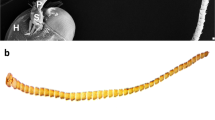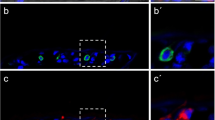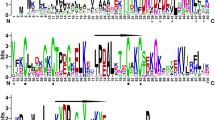Abstract
The distribution of odorant-binding proteins among olfactory sensilla of three moth species was studied by immuno-electron microscopy. Two polyclonal antisera were used in a post-embedding labelling protocol on sections of cryo-substituted antennae. The first was directed against the pheromone-binding protein (PBP) of Antheraea polyphemus, the second against the general odorant-binding protein (GOBP) of the same species. Immunoblots showed that these antisera were highly specific; both antisera did, however, cross-react with related proteins in the related species A. pernyi, and in the bombycid moth B. mori. PBP and GOBP were localized only in olfactory sensilla trichodea and sensilla basiconica, the principal site being the sensillum lymph surrounding the sensory dendrites. In the males of all three species, the pheromone-sensitive long sensilla trichodea exclusively contained PBP. the majority of the sensilla basiconica in both sexes in these species contained GOBP; these sensilla are known to respond to plant and other ‘general’ odours. Some sensilla were not labelled by either antiserum; presumably, these held an odorantbinding protein of a different subfamily. Never were PBP and GOBP co-localized in the same sensillum. Two observations deserve special attention: (1) PBP was also found in a few sensilla in females, and (2) in B. mori, where the long sensilla trichodea have a different functional specificity in males (pheromone) and females (plant odours), the expression of the odorant-binding protein (males: PBP; females: GOBP) is similarly different. The distinct and complex distribution pattern of odorant-binding proteins supports the notion that these proteins participate in stimulus recognition.
Similar content being viewed by others
References
Batteiger B, Newhall WJ, Jones RB (1982) The use of Tween 20 as a blocking agent in the immunological detection of proteins transferred to nitrocellulose membranes. J Immunol Methods 55:297–307
Bienz K, Egger D, Pasamontes L (1986) Electron microscopic immunocytochemistry. Silver enhancement of colloidal gold marker allows double labeling with the same primary antibody. J Histochem Cytochem 34:1337–1342
Boeckh J, Kaißling K-E, Schneider D (1960) Sensillen und Bau der Antennengeißel von Telea polyphemus (Vergleiche mit weiteren Saturniden: Antheraea, Platysamia und Philosamia). Zool Jb Anat 78:559–584
Bradford MM (1976) A rapid and sensitive method for the quantitation of microgram quantities of protein utilizing the principle of protein-dye binding. Anal Biochem 72:248–254
Breer H, Krieger J, Raming K (1990) A novel class of binding proteins in the antennae of the silk moth Antheraea pernyi. Insect Biochem 20:735–740
Danscher G (1981) Localization of gold in biological tissue—a photochemical method for light and electronmicroscopy. Histochemistry 71:81–88
Den Otter CJ, Schuil HA, Sander-Van Oosten A (1978) Reception of host-plant odours and female sex pheromone in Adoxophyes orana (Lepidoptera: Tortricidae): electrophysiology and morphology. Entomol Exp Appl 24:370–378
Du G, Ng C-S, Prestwich GD (1994) Odorant binding by a pheromone binding protein: active site mapping by photoaffinity labeling. Biochemistry 33:4812–4819
Farbman AI (1994) The cellular basis of olfaction. Endeavour 18:2–8
Györgyi TK, Roby-Shemkovitz AJ, Lerner MR (1988) Characterization and cDNA cloning of the pheromone-binding protein from the tobacco hornworm, Manduca sexta: a tissue-specific developmentally regulated protein. Proc Natl Acad Sci USA 85:9851–9855
Heinbockel T, Kaissling K-E (1990) Sensitivity and inhibition of antennal benzoic-acid receptor cells of female silkmoth Bombyx mori L. Verh Dtsch Zool Ges 83:411
Kafka WA (1987) Similarity of reaction spectra and odor discrimination: single receptor cell recordings in Antheraea polyphemus (Saturniidae). J Comp Physiol [A] 161:867–880
Kaissling K-E (1986) Chemo-electrical transduction in insect olfactory receptors. Annu Rev Neurosci 9:121–145
Kaissling K-E (1987) R. H. Wright lectures on insect olfaction. Simon Fraser University Press, Burnaby, Canada
Kaissling K-E, Klein U, De Kramer JJ, Keil TA, Kanaujia S, Hemberger J (1985) Insect olfactory cells: electrophysiological and biochemical studies. In: Changeux JP, Hucho F, Maelicke A, Neumann E (eds) Molecular basis of nerve activity. De Gruyter, Berlin, pp 173–183
Keil TA (1984) Reconstruction and morphometry of silkmoth olfactory hairs: a comparative study of sensilla trichodea on the antennae of male Antheraea polyphemus and Antheraea pernyi (Insecta, Lepidoptera). Zoomorphology 104:147–156
Klein U (1987) Sensillum-lymph proteins from antennal olfactory hairs of the moth Antheraea polyphemus (Saturniidae). Insect Biochem 17:1193–1204
Krieger J, Raming K, Breer H (1991) Cloning of genomic and complementary DNA encoding insect pheromone binding proteins: evidence for microdiversity. Biochim Biophys Acta 1088:277–284
Krieger J, Gänßle H, Raming K, Breer H (1993) Odorant binding proteins of Heliothis virescens. Insect Biochem Mol Biol 23: 449–456
Kyhse-Andersen J (1984) Electroblotting of multiple gels: a simple apparatus without buffer tank for rapid transfer of proteins from polyacrylamide to nitrocellulose. J Biochem Biophys Methods 10:203–209
Laemmli UK (1970) Cleavage of structural proteins during the assembly of the head of bacteriophage T4. Nature 227:680–685
Laue M, Steinbrecht RA, Ziegelberger G (1994) Immunocytochemical localization of general odorant-binding protein in olfactory sensilla of the silkmoth Antheraea polyphemus. Naturwissenschaften 81:178–180
Ljungberg H, Anderson P, Hansson BS (1993) Physiology and morphology of pheromone-specific sensilla on the antennae of male and female Spodoptera littoralis (Lepidoptera: Noctuidae). J Insect Physiol 39:253–260
Maida R, Steinbrecht RA, Ziegelberger G, Pelosi P (1993) The pheromone binding protein of Bombyx mori: purification, characterization and immunocytochemical localization. Insect Biochem Mol Biol 23:243–253
Maida R, Laue M, Steinbrecht RA, Ziegelberger G (1995) Biochemical and immunocytochemical characterization of odorant-binding proteins in moths. In: Elsner N, Menzel R (eds) Göttingen neurobiology report 1995, vol 2. Thieme, Stuttgart New York, p 373
Marshall AT, Kent M (1991) A device for freeze-substituting a large number of samples under controlled conditions. J Microsc 162:335–340
McKenna MP, Hekmat-Scafe DS, Gaines P, Carlson JR (1994) Putative Drosophila pheromone-binding proteins expressed in a subregion of the olfactory system. J Biol Chem 269: 16340–16347
Meng LZ, Wu CH, Wicklein M, Kaissling K-E, Bestmann HJ (1989) Number and sensitivity of three types of pheromone receptor cells in Antheraea pernyi and Antheraea polyphemus. J Comp Physiol [A] 165:139–146
Nesbitt BF, Beevor PS, Cole RA, Lester R, Poppi RG (1973) Sex pheromones of two noctuid moths. Nature 244:208–209
Newman GR, Jasani B, Williams ED (1983) A simple post-embedding system for the rapid demonstration of tissue antigens under the electron microscope. Histochem J 15:543–555
Ozaki M, Morisaki K, Idei W, Ozaki K, Tokunaga F (1995) A putative lipophilic stimulant carrier protein commonly found in the taste and olfactory systems: a unique member of pheromone-binding protein superfamily. Eur J Biochem 230: 298–308
Palanaswamy P, Seabrook WD (1978) Behavioral responses of the female eastern spruce budworm Choristoneura fumiferana (Lepidoptera, Tortricidae) to the sex pheromone of her own species. J Chem Ecol 4:649–655
Pelosi P (1994) Odorant-binding proteins. Crit Rev Biochem Mol Biol 29:199–228
Pelosi P, Maida R (1995) Odorant-binding proteins in insects. Comp Biochem Physiol [B] 111:503–504
Pevsner J, Sklar PB, Snyder SH (1986) Odorant-binding protein: localization to nasal glands and secretions. Proc Natl Acad Sci USA 83:4942–4946
Pikielny CW, Hasan G, Rouyer F, Rosbash M (1994) Members of a family of Drosophila putative odorant-binding proteins are expressed in different subsets of olfactory hairs. Neuron 12: 35–49
Priesner E (1979) Progress in the analysis of pheromone receptor systems. Am Zool Ecol Anim 11:533–546
Priesner E (1980) Sensory encoding of pheromone signals and related stimuli in male moths. In: Insect neurobiology and insecticide action (Neurotox 79). Society of Chemical Industry London, pp 359–366
Raming K, Krieger J, Breer H (1989) Molecular cloning of an insect pheromone-binding protein. FEBS Lett 256:215–218
Raming K, Krieger J, Breer H (1990) Primary structure of a pheromone-binding protein from Antheraea pernyi: homologies with other ligand-carrying proteins. J Comp Physiol [B] 160: 503–509
Saad AD, Scott DR (1981) Repellency of pheromones released by females of Heliothis armigera and H. zea to females of both species. Entomol Exp Appl 30:123–127
Schneider D (1957) Elektrophysiologische Untersuchungen von Chemo- und Mechanorezeptoren der Antenne des Seidenspinners Bombyx mori L. Z Vergl Physiol 40:8–41
Schneider D (1984) Insect olfaction—our research endeavor. In: Dawson WW, Enoch JM (eds) Foundations of sensory science. Springer, Berlin Heidelberg New York, pp 381–418
Schneider D, Kaißling K-E (1957) Der Bau der Antenne des Seidenspinners Bombyx mori L. II Sensillen, cuticulare Bildungen und innerer Bau. Zool Jb Anat 76:223–250
Schneider D, Lacher V, Kaissling K-E (1964) Die Reaktionsweise und das Reaktionsspektrum von Riechzellen bei Antheraea pernyi (Lepidoptera, Saturniidae). Z Vergl Physiol 48:632–662
Seabrook WD, Linn CE, Dyer LJ, Shorey HH (1987) Comparison of electroantennograms from female and male cabbage looper moths (Trichoplusia ni) of different ages and for various pheromone concentrations. J Chem Ecol 13:1443–1453
Steinbrecht RA (1970) Zur Morphometrie der Antenne des Seidenspinners, Bombyx mori L: Zahl und Verteilung der Riechsensillen (Insecta, Lepidoptera). Z Morph Tiere 68:93–126
Steinbrecht RA (1973) Der Feinbau olfaktorischer Sensillen des Seidenspinners (Insecta, Lepidoptera): Rezeptorfortsätze und reizleitender Apparat. Z Zellforsch Mikrosk Anat 139:533–565
Steinbrecht RA (1980) Cryofixation without cryoprotectants. Freeze substitution and freeze etching of an insect olfactory receptor. Tissue Cell 12:73–100
Steinbrecht RA (1987) Functional morphology of phermone-sensitive sensilla. In: Prestwich GD, Blomquist GJ (eds) Pheromone biochemistry. Academic Press, Orlando, pp 353–384
Steinbrecht RA (1993) Freeze-substitution for morphological and immunocytochemical studies in insects. Microsc Res Tech 24: 488–504
Steinbrecht RA, Ozaki M, Ziegelberger G (1992) Immunocytochemical localization of pheromone-binding protein in moth antennae. Cell Tissue Res 270:287–302
Steinbrecht RA, Laue M, Zhang S-G, Giegelberger G (1994) Immunocytochemistry of odorant-binding proteins. In: Kurihara K, Suzuki N, Ogawa H (eds) Olfaction and taste XI. Springer, Tokyo Berlin, pp 804–807
Todd JL, Baker TC (1993) Response of single antennal neurons of female cabbage loopers to behaviorally active attractants. Naturwissenschaften 80:183–186
Tuccini A, Maida R, Rovero P, Mazza M, Pelosi P (1995) Putative odorant-binding protein in antennae and legs of Carausius morosus. Insect Biochem Mol Biol (in press)
Van den Berg MJ, Ziegelberger G (1991) On the function of the pheromone binding protein in the olfactory hairs of Antheraea polyphemus. J Insect Physiol 37:79–85
Visser JH (1986) Host odor perception in phytophagous insects. Annu Rev Entomol 31:121–144
Vogt RG (1987) The molecular basis of pheromone reception: its influence on behavior. In: Prestwich GD, Blomquist GJ (eds) Pheromone biochemistry. Academic Press, Orlando, pp 385–431
Vogt RG, Riddiford LM (1981) Pheromone binding and inactivation by moth antennae. Nature 293:161–163
Vogt RG, Riddiford LM (1986) Pheromone reception: a kinetic equilibrium. In: Payne TL, Birch MC, Kennedy CEJ (eds) Mechanisms in insect olfaction. Clarendon, Oxford, pp 201–208
Vogt RG, Köhne AC, Dubnau JT, Prestwich GD (1989) Expression of pheromone binding proteins during antennal development in the gypsy moth Lymantria dispar. J Neurosci 9: 3332–3346
Vogt RG, Prestwich GD, Lerner MR (1991a) Odorant-binding-protein subfamilies associate with distinct classes of olfactory receptor neurons in insects. J Neurobiol 22:74–84
Vogt RG, Rybezynski R, Lerner MR (1991b) Molecular cloning and sequencing of general odorant-binding proteins GOBP1 and GOBP2 from the tobacco hawk moth Manduca sexta: comparisons with other insect OBPs and their signal peptides. J Neurosci 11:2972–2984
Ziegelberger G (1995) Redox-shift of the pheromone-binding protein in the silkmoth Antheraea polyphemus. Eur J Biochem (in press)
Author information
Authors and Affiliations
Additional information
Dedicated to Professor Ya.A. Vinnikov on the occasion of his 85. birthday
This work was partly supported by DFG grant ste 501/3-1.
Rights and permissions
About this article
Cite this article
Steinbrecht, R.A., Laue, M. & Ziegelberger, G. Immunolocalization of pheromone-binding protein and general odorant-binding protein in olfactory sensilla of the silk moths Antheraea and Bombyx . Cell Tissue Res 282, 203–217 (1995). https://doi.org/10.1007/BF00319112
Received:
Accepted:
Issue Date:
DOI: https://doi.org/10.1007/BF00319112




